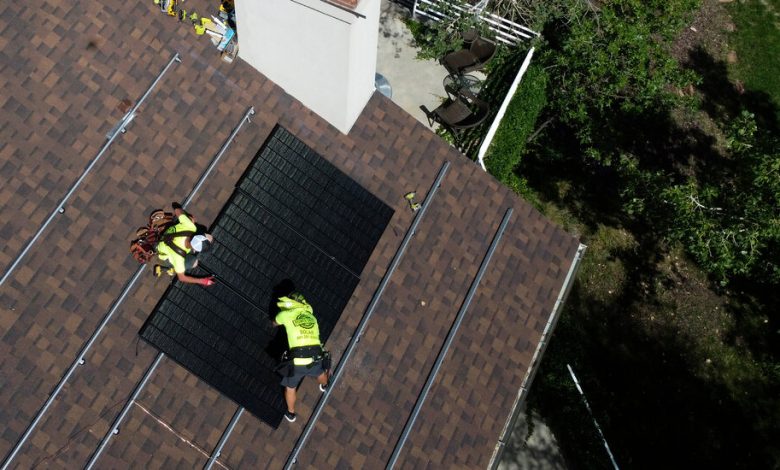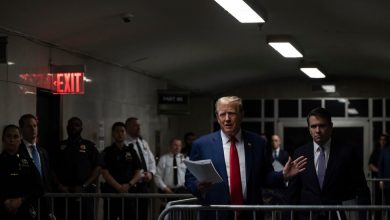U.S. Solar Makers Criticize Biden’s Tax Credits as Too Lax on China

Biden administration rules released on Friday that will determine which companies and manufacturers can benefit from new solar industry tax credits are being criticized by U.S.-based makers of solar products, who say the guidelines do not go far enough to try to lure manufacturing back from China.
The rules stem from President Biden’s sweeping clean energy bill, which offers a mix of tax credits and other incentives to try and spur the construction of more solar factories in the United States and reduce the country’s reliance on China for clean energy goods needed to mitigate climate change.
The Treasury Department, in guidance issued on Friday, said it would offer a 10 percent additional tax credit for facilities assembling solar panels in the United States, even if they import the silicon wafers used to make those panels from foreign countries. Under the Biden administration’s new climate legislation, solar and wind farms can apply for a 30 percent tax credit on the costs of their facilities.
Senior administration officials told reporters on Thursday that they were trying to take a balanced approach, one that leaned toward forcing supply chains to return to the United States. But China’s dominance of the global solar industry has created a tricky calculus for the Biden administration, which wants to promote U.S. manufacturing of solar products but also ensure a plentiful supply of low-cost solar panels to reduce carbon emissions.
The officials said that the Biden administration would have the leeway to change the rules when American supply chains become stronger.
“The domestic content bonus under the Inflation Reduction Act will boost American manufacturing, including in iron and steel, so America’s workers and companies continue to benefit from President Biden’s Investing in America agenda,” Treasury Secretary Janet L. Yellen said in a statement. “These tax credits are key to driving investment and ensuring all Americans share in the growth of the clean energy economy.”
Critics said the new rules would not go far enough to give companies incentives to move the solar supply chain out of China.
Mike Carr, the executive director of the Solar Energy Manufacturers for America Coalition, which includes solar companies with U.S. operations like Hemlock Semiconductor, Wacker Chemie, Qcells and First Solar, called the move “a missed opportunity to build a domestic solar manufacturing supply chain.”
“The simple fact is today’s announcement will likely result in the scaling back of planned investments in the critical areas of solar wafer, ingot, and polysilicon production,” he said in a statement. “China is producing 97 percent of the world’s solar wafers — giving them substantial control over both polysilicon and cell production. We fear that this guidance will cement their dominance over these critical pieces of the solar supply chain.”
The Biden administration has set an ambitious goal of generating 100 percent of the nation’s electricity from carbon-free energy sources by 2035, a goal that may require more than doubling the annual pace of solar installations.
The United States still relies heavily on Chinese manufacturers for low-cost solar modules, although many Chinese-owned factories now make these goods in Vietnam, Malaysia and Thailand.
China also supplies many of the key components in solar panels, including more than 80 percent of the world’s polysilicon, which most solar panels use to absorb energy from sunlight. And a significant portion of Chinese polysilicon comes from the Xinjiang region, where the U.S. government has banned imports because of concerns over forced labor.
Other companies in the solar supply chain, which rely on imported components, were more positive about the Treasury Department’s guidance.
Abigail Ross Hopper, the chief executive of the Solar Energy Industries Association, said the guidance was an important step forward that would “spark a flood of investment in American-made clean energy equipment and components.”
“The U.S. solar and storage industry strongly supports onshoring a domestic clean energy supply chain, and today’s guidance will supplement the manufacturing renaissance that began when the historic Inflation Reduction Act passed last summer,” she said.
Congressional Republicans have already targeted the Biden administration’s climate legislation, saying that it fails to set tough guidelines against manufacturing in China and that it may funnel federal dollars to Chinese-owned companies that have set up in the United States.
The Biden administration is also dispensing funding to build up the semiconductor and electric vehicle battery industries. Guidelines for that money include limits on access to so-called foreign entities of concern, like Chinese-owned companies. But the Inflation Reduction Act does not contain guardrails against federal dollars going to the U.S. operations of Chinese solar companies.
In a congressional hearing on April 25, Representative Jason Smith, chairman of the House Ways and Means Committee, pointed to the Florida facilities of JinkoSolar, a Chinese-owned manufacturer, as being eligible for federal tax credits.
“Work at the plant involves robots placing strings of solar cells — which are largely sourced from China — onto a solar panel base,” a fact sheet released by Mr. Smith said.
Mr. Biden has also clashed with domestic solar manufacturers over a separate trade case that would see tariffs imposed on solar products imported from Chinese companies based in Southeast Asia.
Mr. Biden’s decision to waive the tariffs for two years angered Republicans and some Democrats in Congress, who said U.S.-based manufacturers deserved more protection. In recent weeks, the House and Senate approved a measure to reverse the president’s decision, which Mr. Biden is expected to veto.




